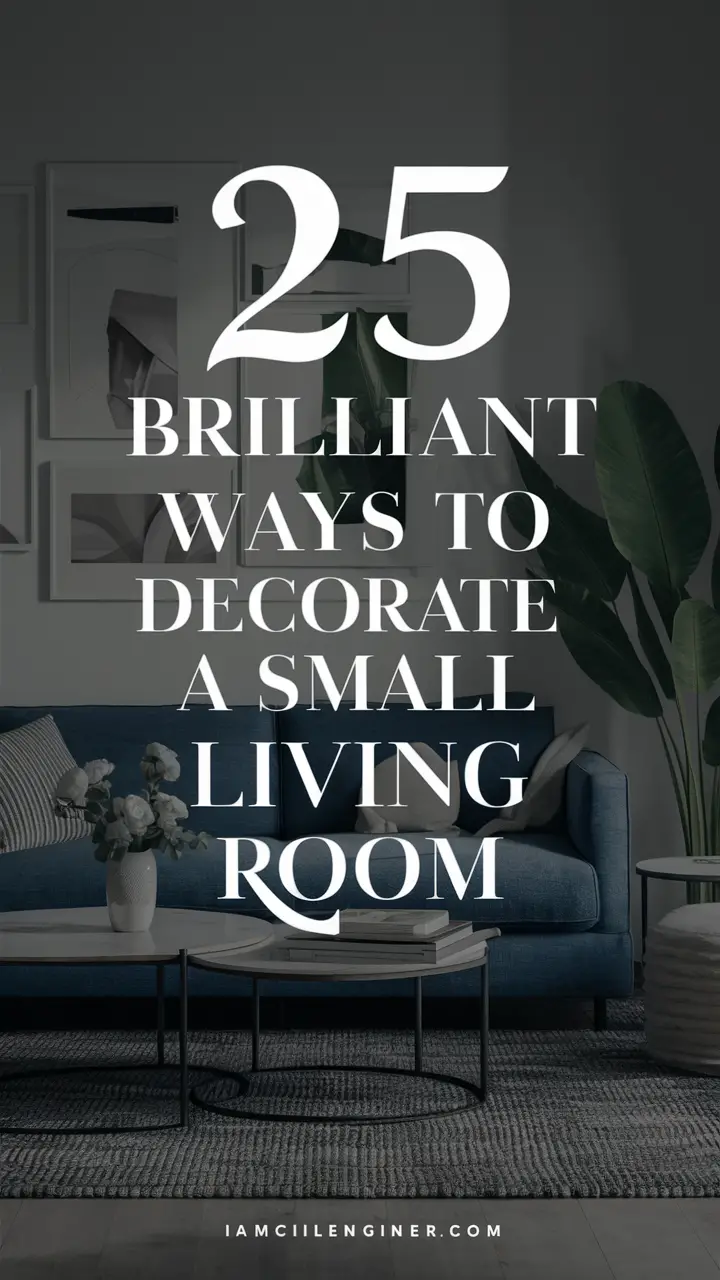## Enhancing Your Small Living Room with Style and Comfort
When it comes to small living rooms, the key to creating a space that feels welcoming and spacious is all about clever design and careful planning. Even the smallest of spaces can be transformed into a haven of comfort and style with the right approach. In this article, we’ll explore some top tips and tricks for making the most of your small living room, from maximizing natural light to selecting the perfect furniture.
## Understanding the Importance of Lighting
Lighting can make or break the ambiance of a room. In a small living room, it’s particularly important to get lighting right. One of the most effective ways to enhance natural light is by using mirrors. Mirrors are magic when it comes to boosting light in a small room. By hanging a large mirror opposite your window, you can reflect natural light and create the illusion of a brighter, more spacious room. Alternatively, creating a gallery wall with smaller mirrors can add a stylish touch and help distribute light evenly throughout the space.
## Choosing the Perfect Color Palette
The color palette you choose for your small living room can significantly impact how spacious it feels. Dark colors can make a room feel smaller, while light colors can create the illusion of more space. Shades like soft beige, pale grey, or even pastels reflect light and make your living room feel bigger. A light palette creates a calm, airy atmosphere that instantly opens up your space without overwhelming it. On the other hand, if you’re looking for a bold statement, consider color drenching – painting your walls, ceilings, skirting boards, and even radiator in the same shade. This seamless approach blurs boundaries and makes your living room feel larger and more cohesive.
## Making the Most of Your Vertical Space
One of the most underutilized areas in small living rooms is the vertical space. Instead of cluttering your floor with decorations and furniture, think beyond the ground level. Use floating shelves to display decorative items, mount your TV on the wall, and opt for wall-mounted lights instead of floor lamps. Hanging houseplants add greenery without taking up valuable floor space. By maximizing your vertical space, you keep your room tidy and open up more square footage for other uses.
## Selecting the Right Furniture
Furniture choice is crucial in small living rooms. Clear furniture, like glass coffee tables, offers function without the visual bulk, keeping your room feeling light and airy. Transparent pieces blend into the background, making them perfect for small spaces where you want to maintain an open feel without sacrificing practical surfaces. Additionally, furniture with legs, like a raised sofa or side table, gives the illusion of more space by showing off the floor underneath. This simple trick allows light to flow through your room more easily, making it feel brighter and more expansive.
## Utilizing Corner Spaces
Awkward corners can be challenging to use efficiently in small living rooms. However, a small corner sofa could be just the solution you need. It maximizes seating without crowding the room and can transform an awkward spot into a cozy nook. Perfect for small gatherings or just stretching out with a good book, a corner sofa is a versatile piece of furniture that can make the most of your space.
## The Power of Statement Rugs
A bold rug can anchor your living room and create the illusion of more space. Choose a large, eye-catching design that fits under your furniture to make the room feel cohesive. The right rug adds personality and warmth while helping to define your space. It’s also a great way to introduce a pop of color or texture into your room, making it feel more vibrant and inviting.
## Displaying Art for Maximum Impact
Displaying art at eye level can make your room feel taller. Hanging framed art or prints at this level draws attention upward, creating a sense of balance and proportion. This small design trick can help your living room feel more spacious. Don’t be afraid to mix and match different sizes and styles to create a dynamic gallery wall that reflects your personality and adds visual interest to your space.
## Keeping the Floor Clear
A cluttered floor can make any room feel smaller. Keep pathways open and free from unnecessary items. Select furniture that doesn’t sit directly on the floor and use shelves or wall-mounted storage to keep things off the ground. This will not only make your room feel more spacious but also reduce the effort needed to clean and maintain it.
Like Us on Facebook!
## Creating a Focal Point
Even in a small room, a striking focal point can make a big impact. Whether it’s a bold piece of art, a statement light fitting, or a vibrant feature wall, directing attention to one key element draws the eye and distracts from the room’s size. Be bold and let your style shine. A well-placed focal point can create a sense of depth and visual interest, making your small living room feel more engaging and dynamic.
Subscribe Us on YouTube!
## The Benefits of Low Furniture
Low furniture, like a sofa with a lower back or a coffee table that sits closer to the floor, creates the illusion of taller ceilings. This trick makes your living room feel more spacious and open, giving you the cozy comfort you need without compromising on style. Low-profile furniture is especially useful in rooms with low ceilings, as it helps to maintain a sense of openness and airflow.
## Incorporating Built-in Storage
Built-in storage solutions are perfect for small spaces. Shelving units, cabinets, or even a window seat with storage underneath keep everything neatly tucked away while saving floor space. Built-ins blend seamlessly into your room, making it feel larger and more organized. This is particularly useful in small living rooms where clutter can quickly accumulate and make the space feel cramped.
## Playing with Textures
Adding interest to your small living room by layering different textures can make it feel more inviting and cozy. Think soft throws, plush rugs, and woven baskets. Mixing textures adds warmth and depth to your space without cluttering it. It’s a great way to make your room feel snug and welcoming, perfect for relaxing after a long day.
## The Versatility of Foldable Furniture
Flexible furniture is a game-changer in small living rooms. Foldable tables or extendable desks can be tucked away when not in use, freeing up space for other activities. It’s the perfect solution for multifunctional rooms where you need to maximize every square inch. This kind of furniture allows you to adapt your space to different needs, whether it’s for work, entertainment, or relaxation.
## Streamlining Your Furniture
Chunky furniture can overwhelm a small room. Instead, choose sleek, slimline pieces with clean lines that offer function without the bulk. A streamlined sofa or a simple coffee table not only saves space but also creates a more open and modern look. In small living rooms, less is often more. Opting for minimalist furniture can help maintain a sense of openness and make your room feel larger than it actually is.
## Choosing Furniture with Storage
Double up on functionality by choosing furniture that offers hidden storage. An ottoman with storage inside, or a coffee table with shelves, gives you extra space to tuck away clutter, while keeping your room tidy and stylish. It’s all about making every piece in your room work harder. Furniture with storage is a practical solution for small spaces, helping to keep your living room organized and clutter-free.
## The Impact of Flooring on Space
Busy patterns can make your floor feel chaotic and shrink your space visually. Stick to simple flooring, like wood effect laminate or neutral carpet, to create a seamless flow. If you love a bit of pattern, save it for a statement rug that can anchor the room without overwhelming it. The right flooring can make a significant difference in how spacious your room feels, so it’s worth choosing carefully.
## Embracing Dark Colors
Rich, dark hues can add depth and drama to a small room when balanced with lighter elements. Try deep blues or charcoal greys on your walls, then soften the look with lighter furniture and accessories. A mix of light and dark tones adds contrast and character without shrinking your space. Dark colors can be particularly effective in creating a cozy atmosphere, making your small living room feel like a snug retreat.
## Layering Your Lighting
Don’t rely on just one light source. Mix and match overhead lighting with floor lamps, wall lights, and table lamps. Layered lighting not only adds warmth and depth to your room, but it also helps you to create different moods. It’s all about setting the right atmosphere for every occasion, whether you’re relaxing, entertaining, or working. Proper lighting can transform your space, making it feel more inviting and functional.
## Keeping Window Dressings Minimal
Heavy curtains can make a small room feel closed in. Instead, opt for light and airy fabrics or streamlined blinds that let natural light flood in. This will create a cleaner look and make your space feel brighter and more expansive. Let the sunlight work its magic by keeping your window treatments simple and unobtrusive.
## Investing in Multifunctional Pieces
Furniture that serves multiple purposes is key in a small lounge. Consider a sofa bed for overnight guests, or a coffee table that doubles up as a desk. Choose versatile furniture for your small living room that will help you get the most out of your space. Giving you both functionality and style in one clever package, multifunctional furniture is a smart way to maximize your space without compromising on comfort or aesthetics.
## Creating Zones in Your Living Room
In a small living room, defining different areas can help make the space feel larger. Use rugs, lighting, room dividers, or furniture placement to create zones for lounging, working, or entertaining. Zoning breaks up the room and gives it structure, making it feel more purposeful, and a lot less cramped. By creating distinct areas, you can make your small living room feel like a more spacious and functional space.
## Mounting Your TV to the Wall
Avoid bulky entertainment units that dominate the room. Instead, mount your TV to the wall to free up floor space. This not only makes your room feel more spacious but also reduces clutter. Mounting your TV is a simple and effective way to enhance your viewing experience while maintaining a clean and organized living room.
## Embracing Minimalism
When in doubt, keep it simple. Focus on essential furniture and décor and avoid overcrowding your space with unnecessary items. A minimalist approach helps your small living room feel larger and more serene, giving you a peaceful, uncluttered space to unwind after a stressful day. By embracing minimalism, you can create a sense of calm and openness in your small living room, making it the perfect retreat for relaxation and entertainment.
## FAQs
– Q: How can I make my small living room feel more spacious?
A: You can make your small living room feel more spacious by using light colors on the walls, maximizing natural light, and choosing furniture that is proportional to the size of the room.
– Q: What type of lighting is best for a small living room?
A: Layered lighting that includes a combination of overhead lighting, floor lamps, and table lamps can help create a sense of depth and make the room feel more spacious.
– Q: How can I choose the right furniture for my small living room?
A: Choose furniture that is multifunctional, has a low profile, and is proportional to the size of the room. Consider furniture with storage to keep clutter at bay.
– Q: Are dark colors suitable for small living rooms?
A: Yes, dark colors can be suitable for small living rooms if balanced with lighter elements. They can add depth and drama to the space.
– Q: How important is it to keep the floor clear in a small living room?
A: Keeping the floor clear is very important in a small living room. It helps create a sense of openness and makes the room feel more spacious. Use wall-mounted storage and furniture with legs to keep the floor clear.
– Q: What is the benefit of using mirrors in a small living room?
A: Mirrors can help reflect natural light and create the illusion of a larger space. They can also add depth and visual interest to the room.
– Q: Can I use patterned flooring in a small living room?
A: It’s generally recommended to avoid busy patterns on the floor in small living rooms, as they can make the space feel chaotic and smaller. Instead, opt for simple, neutral flooring that creates a seamless flow.
– Q: How can I create different zones in my small living room?
A: You can create different zones in your small living room by using rugs, lighting, room dividers, or furniture placement. This helps define areas for lounging, working, or entertaining and makes the space feel more purposeful.
– Q: What are some benefits of minimalist décor in a small living room?
A: Minimalist décor can help a small living room feel larger and more serene. It reduces clutter and visual noise, creating a peaceful and uncluttered space to relax and unwind.





















